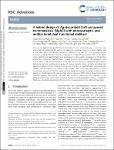Browsing by Author Pham, Tuyet Nhung
Showing results [1 - 4] / 4
In this work, Ag@ZnO and Ag@ZnO/MgAC photocatalysts were synthesized using a simple two-step electrochemical method by the addition of magnesium aminoclay (MgAC) as a great stabilizer and a Lewis base, which could donate electrons for reduction of Ag+ and Zn2+ ions, facilitating uniform formation as well as effective inhibition of aggregation of Ag@ZnO nanoparticles (NPs) on the MgAC matrix. Ag@ZnO and Ag@ZnO/MgAC were investigated for photocatalytic degradation of MB and their antibacterial efficiencies. Ag@ZnO/MgAC showed excellent photocatalytic MB degradation with a performance of 98.56% after 80 min of visible-light irradiation and good antibacterial activity against Salmonella (... |
The present work reports efficient electrochemical nanosensors for the sensitive monitoring of 4-nitrophenol (4-NP) in tomato samples using various biosynthesized silver nanoparticles (bio-AgNPs). Three different bio-AgNP types were synthesized using natural plant extracts, including green tea (GT) leaf, grapefruit peel (GP), and mangosteen peel (MP), aiming to investigate their effects on the formation of bio-AgNPs, as well as the analytical performance of 4-NP. Based on the obtained results, it was found that the phytochemical content in various plant extracts directly influenced the physicochemical parameters of the created bio-AgNPs, such as particle size, crystallinity, and distr... |
The present work reports efficient electrochemical nanosensors for the sensitive monitoring of 4-nitrophenol (4-NP) in tomato samples using various biosynthesized silver nanoparticles (bio-AgNPs). Three different bio-AgNP types were synthesized using natural plant extracts, including green tea (GT) leaf, grapefruit peel (GP), and mangosteen peel (MP), aiming to investigate their effects on the formation of bio-AgNPs, as well as the analytical performance of 4-NP. Based on the obtained results, it was found that the phytochemical content in various plant extracts directly influenced the physicochemical parameters of the created bio-AgNPs, such as particle size, crystallinity, and distr... |
The development of spinel ferrite nanomaterial (SFN)-based hybrid architectures has become more popular owing to the fascinating physicochemical properties of SFNs, such as their good electro-optical and catalytic properties, high chemothermal stability, ease of functionalization, and superparamagnetic behaviour. Furthermore, achieving the perfect combination of SFNs and different nanomaterials has promised to open up many unique synergistic effects and advantages. Inspired by the above-mentioned noteworthy properties, numerous and varied applications have been recently developed, such as energy storage in lithium-ion batteries, environmental pollutant monitoring, and, especially, bio... |



